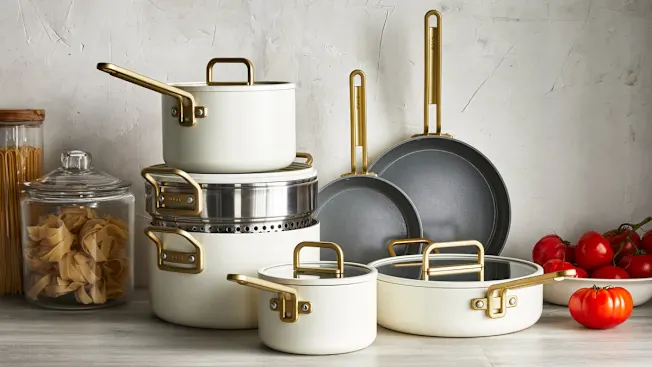A Culinary Guide: Unpacking the Merits of Stainless Steel, Cast Iron, and Non-Stick Cookware
Choosing the right cookware is a pivotal decision for any home cook or professional chef, directly impacting the outcome of a dish. The three most common materials—stainless steel, cast iron, and non-stick—each offer a unique set of features, benefits, and drawbacks. Understanding these differences is key to building a versatile and long-lasting kitchen arsenal.
Stainless Steel: The Durable All-Rounder
Stainless steel cookware is a staple in both professional and home kitchens, prized for its durability and versatility. [1] It is a metal alloy, primarily composed of iron and chromium, with other elements like nickel sometimes added to enhance its properties. [2] For instance, 18/10 stainless steel contains 18% chromium and 10% nickel, offering high resistance to corrosion. [2][3]
Key Features and Benefits:
- Durability: Stainless steel is highly resistant to corrosion, scratches, and dents, ensuring a long lifespan with proper care. [4] It can withstand high temperatures, making it safe for both stovetop and oven use. [4][5]
- Versatility: This type of cookware is suitable for a wide array of cooking methods, including searing, sautéing, frying, browning, and boiling. [4][5] It can be used on any type of cooktop, including induction. [5]
- Non-Reactivity: Stainless steel does not react with acidic or alkaline ingredients, which means it won’t alter the flavor or color of your food. [1][5] This makes it ideal for cooking with ingredients like tomatoes and wine. [2]
- Heat Distribution: While stainless steel itself isn’t the best heat conductor, high-quality stainless steel cookware often features a multi-layered construction, or “cladding,” with a core of a more conductive metal like aluminum or copper. [5][6] This construction ensures even heat distribution and retention, preventing hot spots. [4][5]
- Easy Maintenance: Generally, stainless steel cookware is easy to clean with just soap and water and is often dishwasher safe. [3][4]
Considerations:
- Food can stick to the surface if not preheated properly or if insufficient oil is used. [5]
- Lower-quality stainless steel may not distribute heat as evenly, leading to inconsistent cooking results. [7]
Cast Iron: The Heirloom Workhorse
Valued for its exceptional heat retention and longevity, cast iron cookware has been a favorite for centuries. [8][9] Made by pouring molten iron into a mold, this heavy-duty cookware can last for generations with proper care. [9]
Key Features and Benefits:
- Superior Heat Retention: Cast iron heats up slowly but retains heat incredibly well, providing even and consistent cooking. [9][10] This makes it perfect for searing meats, frying, and long-cooking stews. [8]
- Durability: Cast iron is extremely tough and can withstand very high temperatures, making it suitable for use on the stovetop, in the oven, and even over an open fire. [9][11]
- Natural Non-Stick Surface: When properly seasoned—a process of baking on layers of oil—cast iron develops a natural, non-stick surface. [8][9] This seasoning improves with each use. [10]
- Versatility: It can be used for a wide variety of cooking methods, including frying, searing, baking (cornbread and cobblers are classic examples), braising, and roasting. [8][11]
- Adds Iron to Food: Cooking with cast iron can leach small amounts of iron into your food, which can be a dietary benefit for those with iron deficiencies. [9][11]
Considerations:
- Weight: Cast iron is significantly heavier than other types of cookware, which can make it difficult to handle. [11][12]
- Maintenance: It requires special care. It must be seasoned to create and maintain its non-stick surface and prevent rust. [8] It is not typically dishwasher safe and should be dried thoroughly after washing to prevent rusting. [8][13]
- Reactivity: Bare cast iron can react with acidic foods, which can strip the seasoning and impart a metallic taste to the dish. [8] Enameled cast iron, which has a protective coating, does not have this issue. [12]
- Uneven Heating: If heated too quickly or on a small burner, it can heat unevenly. [8]
Non-Stick Cookware: The Convenient Choice
Non-stick cookware is a popular choice for its ease of use and cleanup. [14] The cooking surface is coated with a material engineered to prevent food from sticking. [15] Historically, this coating was often Teflon (polytetrafluoroethylene or PTFE), but modern options also include ceramic and granite-like coatings. [12][15]
Key Features and Benefits:
- Excellent Food Release: The primary advantage is its non-stick surface, which allows food to slide off easily. [14] This makes it ideal for delicate foods like eggs, pancakes, and fish. [12]
- Easy to Clean: Because food doesn’t stick, cleanup is generally very simple, often requiring just a wipe with a cloth or sponge. [12][14]
- Less Oil Needed: The non-stick surface reduces the need for cooking with large amounts of oil or butter, which can be a healthier option. [12][16]
- Lightweight: Non-stick pans, often with an aluminum base, are typically much lighter than cast iron. [14]
Considerations:
- Durability: The non-stick coating can scratch and wear off over time, especially if metal utensils are used or if cleaned with abrasive materials. [12][14] High-quality non-stick pans with multiple layers of coating tend to last longer. [14]
- Temperature Sensitivity: Most non-stick cookware cannot be used at very high temperatures, as extreme heat can damage the coating. [12]
- Health Concerns: In the past, there were concerns about the chemical PFOA used in the production of some non-stick coatings. However, most modern non-stick cookware is PFOA-free. [12][17]
- Lifespan: Even with proper care, non-stick cookware has a limited lifespan and will eventually need to be replaced once the coating loses its effectiveness. [14]



